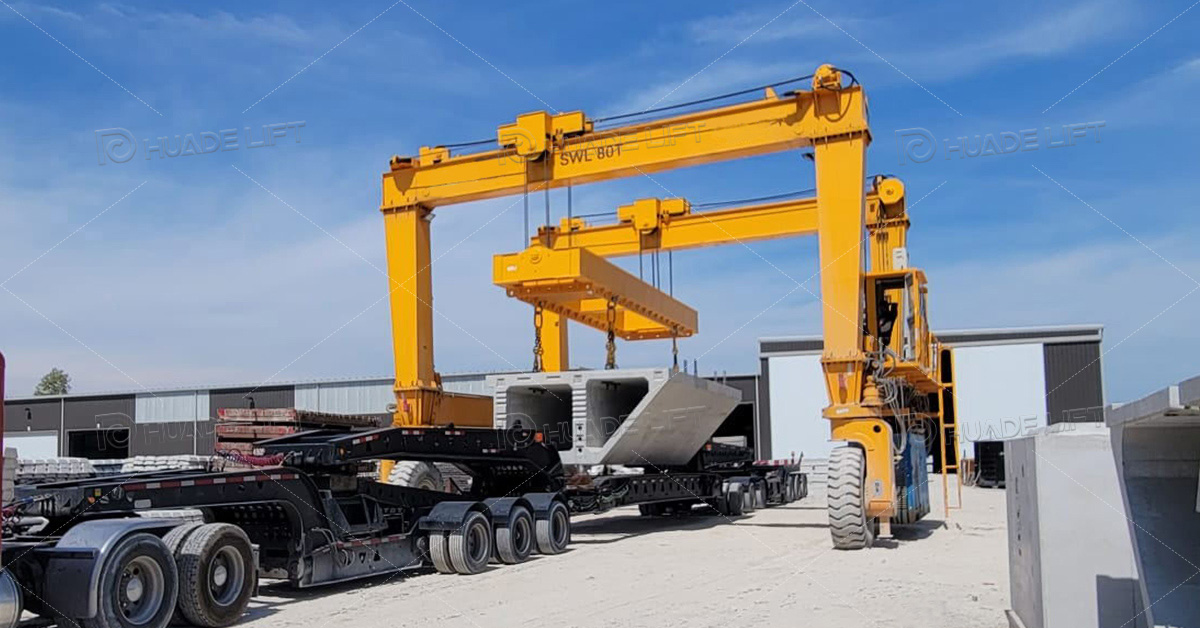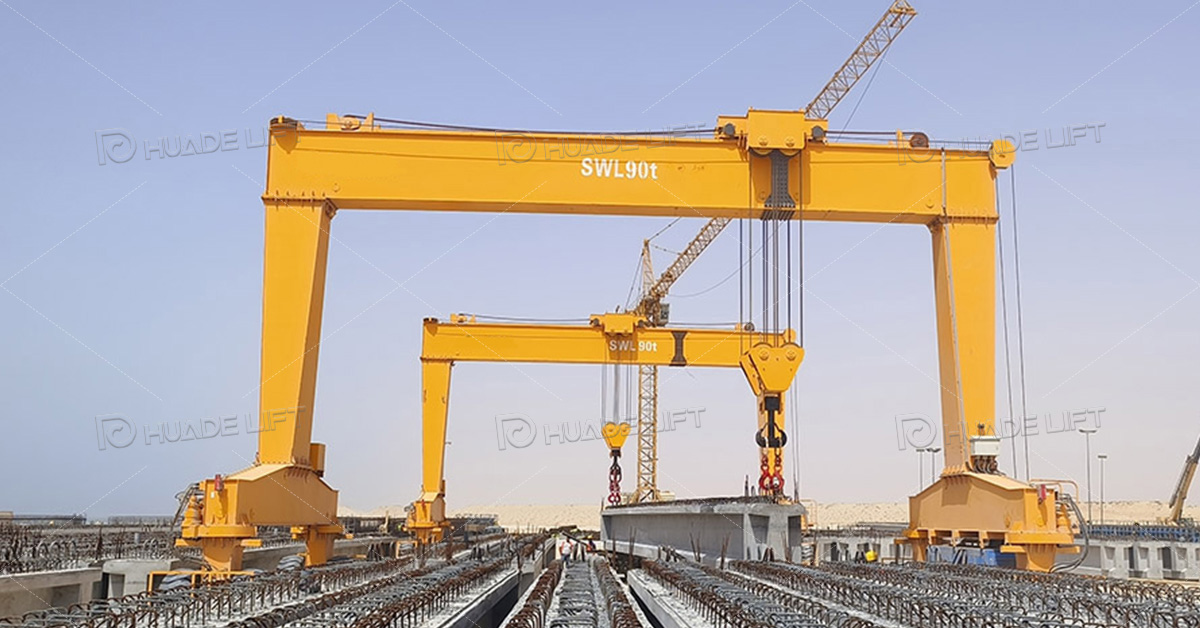Straddle Carriers and Rubber-Tyred Gantry Cranes (RTGs) are two common types of material handling equipment, each with unique design and functional characteristics. Understanding the differences between them is crucial for road and bridge construction, industrial production, container handling, and logistics companies to improve operational efficiency, optimize equipment configuration, and reduce operational costs. This knowledge can help businesses make more informed decisions when selecting equipment that best suits their specific needs.
A straddle carrier is a heavy-duty mechanical device specifically designed for handling and stacking cargo. It features a gantry-style frame structure that can directly straddle cargo, using hydraulically or electrically driven lifting equipment to grasp, lift, and move cargo. Its primary function is to transport cargo horizontally while also possessing some stacking capability. At container terminals, straddle carrier cranes can quickly transport containers from ships to storage yards or perform short-distance transportation and stacking of containers within storage yards. They are also commonly used in logistics parks for handling large cargo units.

Straddle carriers are renowned for their simple operation and flexible handling capabilities. Their main characteristics include:
• High efficiency: capable of rapid loading, unloading, and stacking, suitable for high-density container operations.
• Low energy consumption and maintenance costs: designed with energy efficiency in mind, reducing daily operational and maintenance expenses.
• High adaptability: straddle cranes can be used in various environments, including concrete, gravel, and unpaved surfaces.
Straddle carriers are widely used for transporting heavy loads such as precast beams, concrete blocks, and containers, playing a crucial role in construction sites and logistics centers.
A rubber tyred gantry crane (RTG) is a heavy-duty machine used for container stacking and handling. It moves on rubber tires and can operate flexibly within container yards. RTGs are typically equipped with cable reels for power supply and diesel generators as backup power sources. They are also widely used in various industrial fields, such as ports, logistics, steel mills, and construction sites.
• High load capacity: Capable of handling heavy-duty containers, suitable for the needs of large terminals.
• High stacking density: Enables efficient stacking, saving space and improving storage efficiency.
• Multiple operating modes: Compatible with different control systems, such as wireless remote control and cab control, enhancing operational flexibility.
RTGs are widely used in construction sites, logistics centers, and railway container yards, suitable for use in heavy-duty and high-density operational environments.
Straddle Carrier Functions:
Straddle carriers are primarily used for horizontal transportation and stacking operations. They can directly transport containers from the terminal to the yard and perform stacking operations. Their design emphasizes flexibility, making them suitable for quickly moving vehicles and containers.
Rubber Tyred Gantry Crane Functions:
Rubber tyred gantry cranes focus on vertical lifting and handling heavy loads, enabling efficient operations over a larger range.
Straddle carrier mobility:
A straddle carrier is a self-propelled device equipped with rubber tires, enabling it to move across various terrains. Whether on flat ground, gravel, or unpaved surfaces, the straddle carrier can operate flexibly.
Mobility of Rubber Tyred Gantry Crane:
Rubber tyred gantry cranes have a self-propelled design, but some are fixed-operation devices that require a sturdy foundation and tracks. While rubber tyred gantry cranes are highly stable in operation, track-mounted RTGs lack the flexibility of straddle cranes and have limited mobility.
In terms of operational speed, the straddle carrier demonstrates a significant speed advantage in short-distance handling tasks due to its flexible mobility and rapid horizontal transport capability, enabling it to quickly unload containers from ships or transport vehicles and transfer them to designated locations. However, when it comes to stacking operations involving higher levels, its efficiency is somewhat affected.
In terms of horizontal transportation, if the RTG is rail mounted, it moves relatively slowly due to the need to travel along tracks, and operations such as track switching consume additional time. In terms of environmental conditions, straddle carrier cranes are relatively less affected by environmental factors such as wind and can maintain a certain level of operational capability under harsh weather conditions. Rubber tyred gantry cranes, however, due to their tall gantry structure, often need to reduce operational speed under harsh weather conditions such as strong winds to ensure safety, which affects their operational efficiency.

Straddle carriers exhibit exceptional maneuverability in confined spaces. In container terminals or logistics warehouses with limited space and narrow operational pathways, straddle cranes can efficiently handle cargo handling and stacking tasks thanks to their flexible steering systems and compact vehicle designs. Additionally, straddle carriers demonstrate strong adaptability to changes in operational layout. When businesses need to temporarily adjust operational processes or change cargo storage areas, straddle carrier cranes can quickly adapt to new layouts without requiring large-scale site modifications, thereby reducing operational and time costs.
As mentioned earlier, the load capacity of straddle carriers is relatively limited, and they may not be suitable for handling extremely heavy or oversized cargo. Additionally, the maintenance and operational costs of straddle carrier cranes are relatively high. Due to their frequent movement and complex mechanical structure, components wear out quickly, requiring regular maintenance and servicing, which increases equipment maintenance costs. Furthermore, straddle carriers have relatively high energy consumption, resulting in significant energy costs over extended periods of operation.
Rubber tired gantry cranes have strong load-bearing capacity and can reliably handle heavy cargo. Furthermore, RTG cranes have a stable structure and can maintain reliable operation under various normal working conditions, with relatively low failure rates. Maintenance is relatively concentrated and regular, which facilitates equipment maintenance management for enterprises.
Rubber tyred gantry cranes with track-mounted fixed operations have relatively limited flexibility. Once the tracks are laid, their operational range is largely fixed, making it difficult to adapt to sudden changes in operational requirements or adjustments to the site layout. Furthermore, as mentioned earlier, Rubber tyred gantry cranes are relatively sensitive to environmental factors, and adverse weather conditions such as strong winds or heavy rain may to some extent affect their operational efficiency and safety.
When selecting between a straddle carrier and an RTG, understanding their key differences is crucial. Both have their advantages and disadvantages, and businesses must consider their actual operational needs comprehensively when choosing equipment, such as the size of the operational site, the type and weight of the cargo, the complexity of the operational process, and requirements for operational efficiency and cost. If a company faces limited workspace, variable operational processes, and relatively lightweight cargo, a straddle carrier may be the more suitable choice; however, for large container terminals, logistics parks, and locations requiring the handling of a large volume of heavy cargo with relatively fixed workspace layouts, an rubber tyred gantry crane can maximize its advantages.
If you have any questions about selecting handling equipment or require more detailed equipment information and professional consulting services, please feel free to contact us at any time. Huadelift have a professional team that can provide precise equipment selection recommendations based on your specific needs, helping your business achieve efficient and cost-effective cargo handling operations.